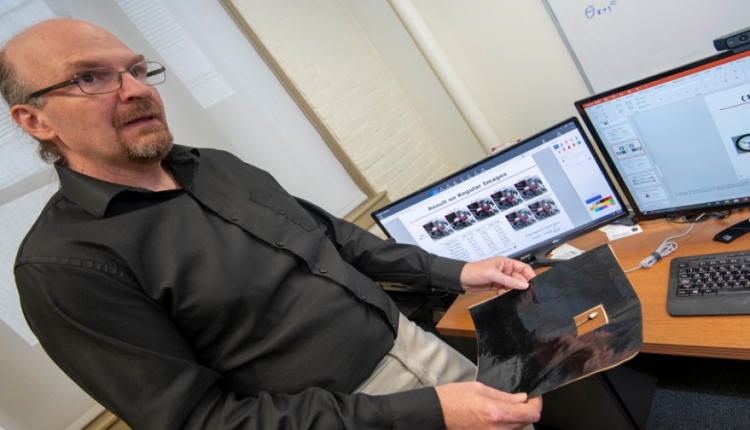Machine Learning and Old Math Team Up in Algorithm to Detect Flaws in NASA Materials
Stronger, lighter, cheaper: that’s the mantra when it comes to creating materials for use in space, whether it’s composite rocket fuel tanks or other spacecraft structures.
By combining cutting-edge machine learning with 19th-century mathematics, a Worcester Polytechnic Institute (WPI) mathematician is working to make NASA spacecraft lighter and more damage tolerant by developing methods to detect imperfections in carbon nanomaterials.
Randy Paffenroth, associate professor of mathematical sciences, computer science, and data science, has a multi-part mission in this research project. Using machine learning, neural networks, and an old mathematical equation, he has developed an algorithm that will significantly enhance the resolution of density scanning systems that are used to detect flaws in carbon nanotube materials. Higher resolution scans provide more accurate images (nine times “super-resolution”) of the material’s uniformity, detecting imperfections in Miralon materials—a strong, lightweight, flexible nanomaterial produced by Nanocomp Technologies, Inc., who funded the research.
Miralon yarns, which can be as thin as a human hair, can be wrapped around structures like rocket fuel tanks, giving them the strength to withstand high pressures. Imperfections and variations in thickness can cause weak spots in the yarn and the resulting composite. Paffenroth, with a team of graduate students, is analyzing data from the manufacturing process to help ensure a more consistent end product.
Nanocomp uses a modified commercial “basis weight” scanning system that scans the nanomaterial for mass uniformity and imperfections, creating a visual image of density; Paffenroth and his team are using machine learning to train algorithms to increase the resolution of the images, allowing the machine to detect more minute variations in the material. They have developed a unique mathematical “compressed sensing / super-resolution” algorithm that has increased the resolution by nine times.
Built with the Python programming language and based on an artificial neural network, the algorithm was “trained” on thousands of sets of nanomaterial images in which Paffenroth had already identified and located flaws. He essentially gave the algorithm a series of practice tests where he already knew the answers (known as “ground truth”). Then, he gave it other tests without the answers. “I give it a sheet of material. I know the imperfections going in but the algorithm doesn’t. If it finds those imperfections, I can trust its accuracy,” said Paffenroth.
To make the machine learning algorithm more effective at making a high-resolution image out of a low-resolution image, he combined it with the Fourier Transform, a mathematical tool devised in the early 1800s that can be used to break down an image into its individual components.
“We take this fancy, cutting-edge neural network and add in 250-year-old mathematics and that helps the neural network work better,” said Paffenroth. “The Fourier Transform makes creating a high-resolution image a much easier problem by breaking down the data that makes up the image. Think of the Fourier Transform as a set of eyeglasses for the neural network. It makes blurry things clear to the algorithm. We’re taking computer vision and virtually putting glasses on it. It’s exciting to use this combination of modern machine learning and classic math for this kind of work.”
Miralon was wrapped around structural supports in NASA’s Juno probe orbiting the planet Jupiter to help a challenging problem with vibration damping and static discharge. NASA has also used Miralon nanomaterials to make and test prototypes of new carbon composite pressure vessels, the precursors to next-generation rocket fuel tanks. NASA spacecraft will need that added strength and durability as they travel farther from home and deeper into space.
As part of its current NASA contract, Nanocomp is trying to make Miralon yarns that are three times stronger. With better measurement tools, improvements in the manufacturing process can be made by testing whether changes in factors like temperature, tension control, pressure, and flow rates create better materials.
Paffenroth and his team will also develop algorithms to be used in active feedback control systems to predict how good a particular piece of material will be as it’s first being made, helping to ensure a more consistent end product. The algorithm analyzes the properties measured at the beginning of the manufacturing run to effectively predict the properties at the end of the run, including mechanical properties and length of run.
“We can use machine learning to predict that Nanocomp won’t get a useful length of material out of a particular production run,” said Paffenroth. “It helps them with waste. If they can tell in the first few meters of the run that there will be a problem, they can stop and start over. The Holy Grail of process engineering is that the more you understand about your process, the better your process is.”
Source: Worcester Polytechnic Institute

